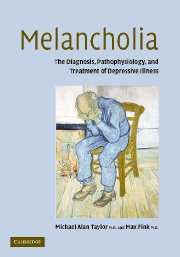Book contents
- Frontmatter
- Contents
- List of patient vignettes
- Preface
- Acknowledgments
- 1 Melancholia: a conceptual history
- 2 Melancholia defined
- 3 Defining melancholia by psychopathology
- 4 Defining melancholia: laboratory tests
- 5 Examination for melancholia
- 6 The differential diagnosis of melancholia
- 7 Suicide in melancholia
- 8 Electroconvulsive therapy for melancholia
- 9 Achieving effective ECT
- 10 The validity of the pharmacotherapy literature in melancholia
- 11 Basic pharmacotherapy for melancholic patients
- 12 Pharmacotherapy for melancholic patients in complicating circumstances
- 13 Proposed treatments for melancholia
- 14 The pathophysiology of melancholia
- 15 Future directions
- References
- Index
7 - Suicide in melancholia
Published online by Cambridge University Press: 14 August 2009
- Frontmatter
- Contents
- List of patient vignettes
- Preface
- Acknowledgments
- 1 Melancholia: a conceptual history
- 2 Melancholia defined
- 3 Defining melancholia by psychopathology
- 4 Defining melancholia: laboratory tests
- 5 Examination for melancholia
- 6 The differential diagnosis of melancholia
- 7 Suicide in melancholia
- 8 Electroconvulsive therapy for melancholia
- 9 Achieving effective ECT
- 10 The validity of the pharmacotherapy literature in melancholia
- 11 Basic pharmacotherapy for melancholic patients
- 12 Pharmacotherapy for melancholic patients in complicating circumstances
- 13 Proposed treatments for melancholia
- 14 The pathophysiology of melancholia
- 15 Future directions
- References
- Index
Summary
I want to die. I can't believe I feel like this. But it's the strongest feeling I know right now, stronger than hope or faith or even love. The aching relentlessness of this depression is becoming unbearable. The thoughts of suicide are becoming intrusive. It's not that I want to die. It's that I'm not sure I can live like this anymore.
Persons with mood disorders are at the greatest risk for suicide, with 50–70% of persons who kill themselves doing so during an episode of depressive illness. Melancholic patients who are agitated and anxious, psychotic, or who have been hypomanic are at the greatest risk. Studies of suicide, however, do not typically identify the melancholic patients in their samples, and so the evidence for risk is mostly indirect. Patients who are severely depressed, or who have abnormal hypothalamic–pituitary–adrenal functioning are likely to be melancholic, but studies associating these factors of increased risk rarely define the form of depressive illness. An exception is a study that compared suicide attempts in a large sample of melancholic and non-melancholic patients. After controlling for severity and baseline characteristics as covariates, the melancholic patients were more likely to have had prior serious suicide attempts and to make more attempts during the follow-up period. Although the cited studies refer to severe depression, it is likely that the majority of patients meet criteria for melancholia.
In early estimates of suicide risk, 15–19% of depressed patients committed suicide.
- Type
- Chapter
- Information
- MelancholiaThe Diagnosis, Pathophysiology and Treatment of Depressive Illness, pp. 125 - 152Publisher: Cambridge University PressPrint publication year: 2006

